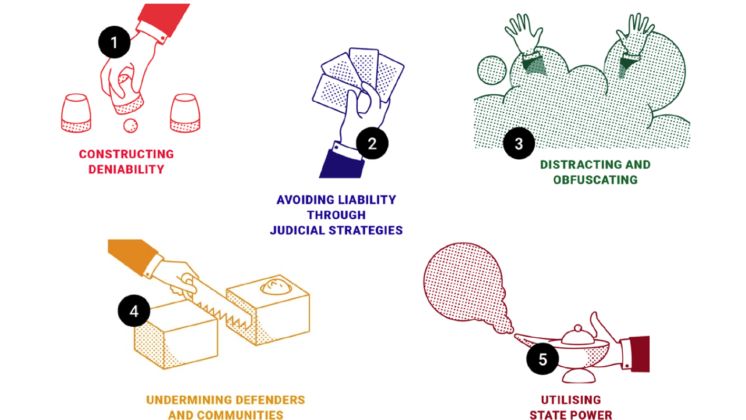A review of academic literature formed the basis for our definition of a harmful strategy. The Mind the Gap project defines a harmful corporate strategy as a series of actions taken by a company that result in avoiding responsibility for human rights or environmental impacts.
Businesses externalise costs to society
Business-related negative human rights and environmental impacts are often a by-product of a company’s strategy[1] to maximise profits, minimise costs, increase competitiveness, or reduce risk.[2] These human rights impacts should be viewed as ‘costs’ generated by the company, but externalised to society. In order to keep these costs external and continue operation without bearing responsibility for those impacts, corporations employ particular strategies. These strategies operate in parallel with the corporations’ primary strategies to generate profit, and are designed to control the corporate environment and result in the avoidance of responsibility for – and the costs related to – human rights impacts.
Harvesting strategies
The research started out with several brainstorming sessions involving staff from all consortium partners on what was considered to be harmful corporate strategies from existing research experience and practice. This yielded an initial list of harmful strategies. From subsequent literature reviews, desk study, and field research five overarching types of corporate strategies emerged that result in avoidance of responsibility for human rights or environmental impacts. Among the factors that distinguished and grouped strategies are the timing of the strategy as well as the institutions, mechanisms, or external actors that are the target of the strategies.
Peer review
With help from a wider set of CSOs and academic actors, the typology of strategies was further refined and peer-reviewed. Public consultations at the 2018 UN Annual Forum on Business and Human Rights with over 50 participants, and the 2019 Annual Meeting of the European Coalition of Corporate Justice with more than 20 participants, yielded feedback on the initial research framework, added further insights and evidence, and provided broad recognition of the relevance of introducing such a framework.
Five main types of harmful corporate strategies
Summary of harmful strategies framework
The result of our research process is a framework of five main harmful corporate strategies under which 25 forms of strategies are grouped:
- Constructing deniability
- Avoiding liability through judicial strategies
- Distracting and obfuscating stakeholders
- Undermining defenders and communities
- Utilising state power
Harmful, yet widely accepted
The strategies identified are not inherently illegal. In fact, some strategies that fall under this definition are legal and widely accepted by managers, consultants, auditors, legal advisors, and other stakeholders as a way to protect corporate and shareholders’ interests and are often made possible by systemic power imbalances (e.g. unequal access to resources: natural, financial, judicial, media, political networks). While serving business interests, these strategies can have harmful effects on society or the environment.
[1] Kenneth R. Andrews, “The Concept of Corporate Strategy,” Resources, Firms, and Strategies: A Reader in the Resource-based Perspective (Oxford: Oxford University Press, 1997), 52-59.
[2] Robert M. Grant, Contemporary Strategy Analysis: Text and Cases Edition (Chichester: John Wiley & Sons, 2016), 480.

